 One good reason for handloading the .223 Remington would be it’s small size. Small cartridge size interprets into small costs for the most advanced bullet and powder technology, as well as small costs for material storage and process tools. Is this savings significant? On almost any Saturday afternoon, I can catch a sale at the local gun store, and pick up 8 boxes of quality .223 loaded ammo, for the same price I pay for 50 component Barnes bullets for my .338-378. I can buy 100 match grade bullets for the .223 Remington for about $10, but pay 8 times as much for the same in .338″ bore.
One good reason for handloading the .223 Remington would be it’s small size. Small cartridge size interprets into small costs for the most advanced bullet and powder technology, as well as small costs for material storage and process tools. Is this savings significant? On almost any Saturday afternoon, I can catch a sale at the local gun store, and pick up 8 boxes of quality .223 loaded ammo, for the same price I pay for 50 component Barnes bullets for my .338-378. I can buy 100 match grade bullets for the .223 Remington for about $10, but pay 8 times as much for the same in .338″ bore.
Obviously, the .223 Remington would not substitute for the .338-378 on a bear hunt, but it is a great selection for recreational and formal target shooting, or as a utility gun. The .223 Remington choice allows a lot more practice and shooting enjoyment, without having to float a second mortgage for that privilege.
Case Preparation
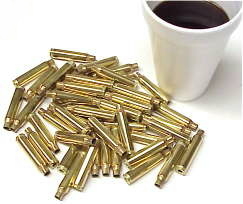 1000 pieces of .223 brass will fit easily into a one quart Ziploc bag. 50 fit nicely next to a cup of coffee, which of course I would never have on my bench for fear of contamination and spillage.
1000 pieces of .223 brass will fit easily into a one quart Ziploc bag. 50 fit nicely next to a cup of coffee, which of course I would never have on my bench for fear of contamination and spillage.
New brass creates a lot of work. Other than being new, it is also rough around the edges, coated with something like machine oil or preservative, dimensionally questionable, and possibly not useable. I first chemically clean all new brass with Birchwood Casey Brass Cartridge Case cleaner, then dump it in the vibratory cleaner for 20 minutes or so, before conducting a detailed and magnified examination of each piece.
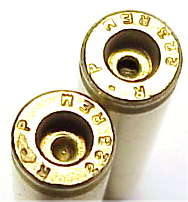 For those of you suspecting I’m perhaps obsessive a little over brass prep, here are two examples pulled during inspection of a 50 piece control lot. 4% of the new Remington brass had filled flash holes, filled to the degree an awl would not open the passage and I had to resort to a numbered drill to remove the blockage.
For those of you suspecting I’m perhaps obsessive a little over brass prep, here are two examples pulled during inspection of a 50 piece control lot. 4% of the new Remington brass had filled flash holes, filled to the degree an awl would not open the passage and I had to resort to a numbered drill to remove the blockage.
I’m not sure, to an absolute degree, what the effect would have been if I had missed these defects and dropped a hammer on primers with no passage for high pressure gases to escape. Intuitively, I’d have to think it wouldn’t be good. Once brass has been used successfully, inspections become a lot more routine, and brass a lot more trustworthy.
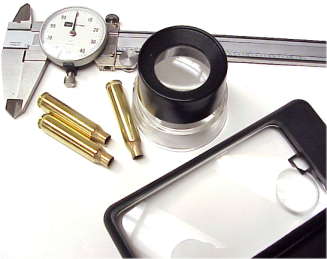 Let me beat this new brass inspection issue to death just a little bit more. I began with three quality reloading manuals. I checked the spec, and made sure the spec matched across all. If I had found a disparity, I would have looked through more until I was sure the mismatched spec was a fluke, or at least a flounder. The existence of disparities is not rare.
Let me beat this new brass inspection issue to death just a little bit more. I began with three quality reloading manuals. I checked the spec, and made sure the spec matched across all. If I had found a disparity, I would have looked through more until I was sure the mismatched spec was a fluke, or at least a flounder. The existence of disparities is not rare.
The maximum case length spec for the .223 Remington is 1.760″ with a trim to length of 1.750″. The .010″ difference is the norm on most cartridges. Overall case length within the 50 piece control lot ranged from 1.748″ to 1.750″; nothing earth shaking. I did have a problem with non-uniform case mouths that caused overall length to be measured +/- .004″, depending on how the case was rotated in the dial caliper jaws. In addition, running each case through the full length sizing die increased overall length by .001″ to .003″, dependant upon the raw case neck inside diameter and the expander ball drag when withdrawn.
 For the sake of uniformity in bullet seating and overall dimensional control, I set up my RCBS case trimmer and cut everything to a uniform 1.750″. This put the cases right on spec.
For the sake of uniformity in bullet seating and overall dimensional control, I set up my RCBS case trimmer and cut everything to a uniform 1.750″. This put the cases right on spec.
With this out of the way, I ran an inside/outside reamer over each case mouth. The result was 50 cases, all very uniform in dimension and quality.
Bullet Selection
I’ve handloaded the .223 Remington for my Contender, but not for a rifle. What can I say, I’m slow to catch onto trends and I’ve been pretty busy since 1957. I was hoping some of the information I developed around the 14″ barreled T/C would carry forward to the short 20″ barrel of the Model Seven, including the 50 and 55 grain short bullet selections, as the Seven has a relatively lazy 1:12 twist. I know those AR15 guys always seem to be going for 100 grain .224 bullets and a 1:5″ twist for best 2,000 yard stability, but I fortunately only have to hit the occasional rodent or large piece of very nearby paper.
|
|
Supplier | Bullet Type | Weight grains | Overall Length | Calculated Twist | Street Cost/100 | |
| Speer | TNT Hollow Point | 50 | .690″ | 1:13.1 | 10.50 | ||
| Hornady | SX Super Explosive | 50 | .650″ | 1:13.9 | 10.50 | ||
|
Combined |
Ballistic Silvertip | 50 | .785″ | 1:11.5 | 17.50 | ||
| Remington bulk | Pointed Soft Point | 50 | .690″ | 1:13.1 | 5.80* | ||
|
* Price per 100 when purchased in 1000 piece lots |
|||||||
From left to right, the first two bullets are for shots at small varmints when environmental clean up requirements are not desired. They are thin jacketed and made to cause maximum damage on contact. The third, and the only boat tail bullet on the list is similar in construction and purpose, but designed more for long range stability and delivery. Finally, a Remington bulk bullet with conventional jacket and exposed soft point which will no doubt see the most use with the Model Seven. Over spin on bullets is not a problem within reasonable limits, and all of these bullets should have no problem stabilizing with the 1:12 twist. The ideal bullet length, calculated with the Greenhill formula is approximately .750″, so there should be no problem moving up to 55 grain and 60 grain bullets if desired, but in the interim the 50 grain bullets should churn up a bit of speed.
Powder Selection
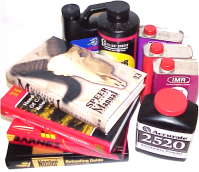 Who knows what thoughts run through the mind of a handloader when selecting powder; there are many factors to consider. I like to start with a comparison of all manuals and credible other load data. I plot a graph or build a table; by powder, by publisher, by velocity per grain.
Who knows what thoughts run through the mind of a handloader when selecting powder; there are many factors to consider. I like to start with a comparison of all manuals and credible other load data. I plot a graph or build a table; by powder, by publisher, by velocity per grain.
Next I look in my powder locker to see what I actually have available, then I look at my prior month’s powder purchase receipts, and carefully consider how my wife will react to new receipts. Let’s not dwell on my wussyboy like tendencies, let’s just see what a table looks like.
| Powder Type |
50 Gr. Bullet |
||||||||||||||
| Grs | Vel | gfps | Grs | Vel | gfps | Grs | Vel | gfps | Grs | Vel | gfps | Grs | Vel | gfps | |
| IMR 4895 | 25.5 | 3379 | 132 | 27.0 | 3300 | 122 | 26.0 | 3260 | 125 | 26.5 | 3200 | 121 | 27.0 | 3313 | 123 |
| IMR 4198 | 22.0 | 3407 | 155 | 22.2 | 3300 | 149 | 22.0 | 3230 | 147 | 22.0 | 3200 | 145 | |||
| IMR 3031 | 25.0 | 3398 | 136 | 25.7 | 3400 | 132 | 25.2 | 3300 | 131 | 26.0 | 3284 | 126 | |||
| AA 2520 | 28.0 | 3328 | 119 | ||||||||||||
| Re 7 | 23.0 | 3424 | 149 | 22.1 | 3200 | 145 | |||||||||
| Win 748 | 28.3 | 3400 | 120 | 26.5 | 3260 | 123 | 28.5 | 3398 | 119 | ||||||
| Manuals > | Barnes #2 | Hornady #5 | Nosler #4 | Sierra #4 | Speer #13 | ||||||||||
|
Barrel length: Sierra 20″, Speer 22″, all other 24″ |
|||||||||||||||
The legends and titles are pretty much self explanatory with the exception of “gfps” or “grains – feet per second”, which is simply the number of fps generated per grain of powder. I use this indicator to determine if a manual is sandbagging with excessive safety margin across all loads. If all loads and powder types are proportionally lower compared to the other manuals, with equal circumstance, sandbagging is quite possible. I also look for flyers where fast powders show a significantly lower level of fps per grain, compared to slower powders.
If I wanted to make a conservative investment in powder, I would look for source consensus. In this case Winchester 748 would be my first choice and IMR 3031 my second choice, since I tend to use velocity as a higher priority and place less faith in accuracy representations in manuals. With the exception of very old type ball powders, I haven’t actually seen much variation in practical accuracy levels with most current products.
In this case, I’m going to load for all of these powder types and see if the results validates this table approach. All of the powders indicated demonstrated some redeeming qualities in one publication or another, so I believe they are all in a practical universe for selection.
I did want to make one comment relating to supply of smokeless powder. I buy powder just like everyone else, so I need to shop around to keep cost at some reasonable level. I am working on another article that compares prices and service levels of suppliers, but I didn’t want to delay in mentioning Lock Stock & Barrel in Valentine, NE. Buying in any reasonable quantity, I’ve been able to save between $4 and $7 per pound over local California prices, and the folks at LS&B will work with you to put together the most cost effective shipment when combining powder, HAZMAT and shipping costs. Like Brownells, another favorite source, LS&B runs a great organization, predicated on high levels of customer service.
Assembly Cartridges
 If you’ve followed any of my work in the past, you’ll see I’ve made a great breakthrough in material handling, I’ve sprung for Winchester loading blocks. I don’t like to rush into anything, but these were pretty nice.
If you’ve followed any of my work in the past, you’ll see I’ve made a great breakthrough in material handling, I’ve sprung for Winchester loading blocks. I don’t like to rush into anything, but these were pretty nice.
I still use bottled RCBS case lube, and I size before trimming and final case cleaning. I have found the spray lubes to be inexact in application, sometimes causing shoulder dimples from too much lube and over spraying my loading bench.
I have never been able to full length size without altering case length, so I still trim afterward. The expander ball just hooks the inside of the case neck at the shoulder and pulls it forward a few of thousands, so there is not much reason to trim before hand. I still have a suspicion that after I play around with the overall case length process, it all goes back to zero when I drive the bolt home and set the shoulder back .003″, or where it was before the expander ball pulled it forward. One day I’ll cut away a barrel and video tape the exact dynamics…sure.
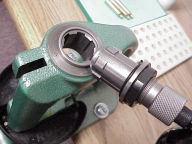 The Lock-N-Load adapters from Hornady for the RCBS Rock Chucker press must be useful, because they haven’t been relegated to the bottom shelf of my tool storage cabinet. I use the adapters all of the time, and progressively add them as each cartridge comes up in rotation to reloading.
The Lock-N-Load adapters from Hornady for the RCBS Rock Chucker press must be useful, because they haven’t been relegated to the bottom shelf of my tool storage cabinet. I use the adapters all of the time, and progressively add them as each cartridge comes up in rotation to reloading.
The adapters really do allow me to plop in a sizing die without any adjustment whatsoever, and they eliminate chasing down tools to loosen and set lock rings.
 Here is my trusty APS press. Another tool that proved to be very practical, and to have a positive effect on cartridge quality.In the case of the .223 Remington, the planned loads require a combination of small rifle and small magnum rifle primers. The APS press allows me to easily change from one type to another and work, quickly, through the entire load sheet. My only grip about this set up is the single flimsy shell holder plastic primer guide they supply with the press. It will wear out quickly, and good luck finding replacements when you’re in a hurry. If you use this system, call RCBS and order a dozen bushings and several internal plastic primer strip detents.
Here is my trusty APS press. Another tool that proved to be very practical, and to have a positive effect on cartridge quality.In the case of the .223 Remington, the planned loads require a combination of small rifle and small magnum rifle primers. The APS press allows me to easily change from one type to another and work, quickly, through the entire load sheet. My only grip about this set up is the single flimsy shell holder plastic primer guide they supply with the press. It will wear out quickly, and good luck finding replacements when you’re in a hurry. If you use this system, call RCBS and order a dozen bushings and several internal plastic primer strip detents.
 This duo’s usefulness was in question for quite some time. In reality, working down a long load list is a very good application for this equipment.
This duo’s usefulness was in question for quite some time. In reality, working down a long load list is a very good application for this equipment.
It takes several minutes to calibrate for each powder type, but you can be doing other work while the scale and dispenser play robot wars and self adjust through infrared port communication. Once set, all you need to do is punch in the amount to be metered and the combination will deliver a very accurate charge. There is an absence of blazing speed, but it would take longer to meter manually and a mechanical scale might not be as accurate. (And then the enjoyment of a new toy wore off and I never used it again – too slow, too inflexible.)
I’m going to take a break at this point so I can concentrate on assembly and logging. The next installment should cover anything unique that occurred during the balance of handloading, as well as range results and a wrap up on the Model Seven.
More “The Remington Model Seven”:
The Remington Model Seven…a great place to start
The Seven Project Part I Quick Detach Mount System
The Seven Project Part II Handload Development
‘The Seven Project Part III – even more development
The Seven Project Part IV
Handload Data – 223 Remington
Thanks,
Joe

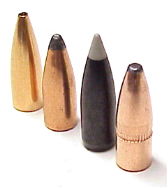
Email Notification